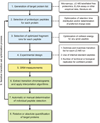An assessment of current bioinformatic solutions for analyzing LC-MS data acquired by selected reaction monitoring technology
- PMID: 22577019
- PMCID: PMC3857306
- DOI: 10.1002/pmic.201100571
An assessment of current bioinformatic solutions for analyzing LC-MS data acquired by selected reaction monitoring technology
Abstract
Selected reaction monitoring (SRM) is an accurate quantitative technique, typically used for small-molecule mass spectrometry (MS). SRM has emerged as an important technique for targeted and hypothesis-driven proteomic research, and is becoming the reference method for protein quantification in complex biological samples. SRM offers high selectivity, a lower limit of detection and improved reproducibility, compared to conventional shot-gun-based tandem MS (LC-MS/MS) methods. Unlike LC-MS/MS, which requires computationally intensive informatic postanalysis, SRM requires preacquisition bioinformatic analysis to determine proteotypic peptides and optimal transitions to uniquely identify and to accurately quantitate proteins of interest. Extensive arrays of bioinformatics software tools, both web-based and stand-alone, have been published to assist researchers to determine optimal peptides and transition sets. The transitions are oftentimes selected based on preferred precursor charge state, peptide molecular weight, hydrophobicity, fragmentation pattern at a given collision energy (CE), and instrumentation chosen. Validation of the selected transitions for each peptide is critical since peptide performance varies depending on the mass spectrometer used. In this review, we provide an overview of open source and commercial bioinformatic tools for analyzing LC-MS data acquired by SRM.
© 2012 WILEY-VCH Verlag GmbH & Co. KGaA, Weinheim.
Conflict of interest statement
The authors declare no financial/commercial conflicts of interest with the work presented here.
Figures
References
-
- Baty JD, Robinson PR. Single and multiple ion recording techniques for the analysis of diphenylhydantoin and its major metabolite in plasma. Biomed. Mass spectrom. 1977;4:36–41. - PubMed
-
- Kovarik P, Grivet C, Bourgogne E, Hopfgartner G. Method development aspects for the quantitation of pharmaceutical compounds in human plasma with a matrixassisted aser desorption/ionization source in the multiple reaction monitoring mode. Rapid Commun. Mass Spectrom. 2007;21:911–919. - PubMed
-
- Gallien S, Duriez E, Domon B. Selected reaction monitoring applied to proteomics. J. Mass Spectrom. 2011;46(3):298–312. - PubMed
Publication types
MeSH terms
Substances
Grants and funding
LinkOut - more resources
Full Text Sources


